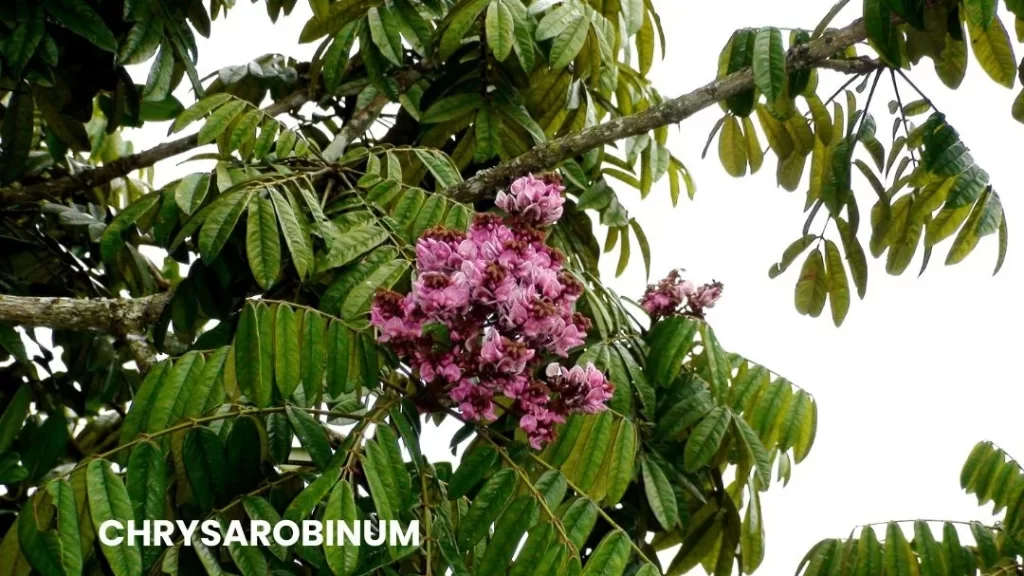Chrysarobinum, derived from the Andira araroba tree, is a homeopathic remedy known for its potent irritant properties and its effectiveness in treating various skin diseases.
It is particularly renowned for its use in conditions such as ringworm, psoriasis, herpes tonsurans, and acne rosacea.
The remedy is characterized by the presence of chrysophan, which plays a critical role in its therapeutic effects.

Table of Contents
ToggleSOURCE INFORMATION
Scientific Classification
- Kingdom: Plantae
- Phylum: Angiosperms
- Class: Eudicots
- Order: Fabales
- Family: Fabaceae
- Genus: Andira
- Species: Andira araroba
Origin
- The Andira araroba tree is native to tropical regions of Central and South America, particularly in the Amazon rainforest.
- The powdered form known as Goa Powder is obtained from the bark of the tree.
Historical Facts
- The use of Chrysarobinum dates back to traditional medicine, where it was utilized for its anti-fungal and skin-soothing properties.
- It gained popularity in dermatology due to its efficacy in managing chronic skin conditions characterized by inflammatory and infectious processes.
DRUG PATHOGENESIS
- Chrysarobinum acts as a strong irritant to the skin, promoting blood circulation in the affected areas.
- This irritant effect aids in the healing of skin diseases by stimulating local immune responses, reducing microbial loads, and enhancing the shedding of dead skin cells.
PHYSICAL CONSTITUTION
- Patients benefiting from Chrysarobinum often present with dry, scaly skin and a history of chronic skin disorders.
- They may exhibit sensitive skin that reacts adversely to various stimuli.
DIATHESIS
- Particularly suited for individuals with a tendency towards skin conditions that are dry, crusted, and may emit a foul smell.
TEMPERAMENTS
- This remedy is often indicated for those with heightened sensitivity to environmental factors, leading to skin exacerbations.
KEY CHARACTERISTICS
- Acts as a powerful irritant to the skin.
- Effectively treats vesicular and squamous lesions.
- Associated with intense itching, particularly in the thighs, legs, and ears.
- Produces dry, scaly eruptions with crusting and foul-smelling discharges.
DETAILED ORGAN SYMPTOMS
SKIN
Conditions Treated
- Ringworm, psoriasis, herpes tonsurans, acne rosacea.
Symptoms
- Violent itching, especially in the thighs and legs.
- Dry, scaly eruptions around the eyes and ears.
- Formation of crusts with pus underneath, leading to confluent lesions.
EYES
- Conditions Treated: Blepharitis, conjunctivitis, keratitis.
Symptoms
- Intense photophobia (sensitivity to light).
- Optical hyperesthesia (increased sensitivity to visual stimuli).
EARS
- Conditions Treated: Eczema behind the ears.
Symptoms
- Filthy, scabby conditions with thick crust formation.
- Surrounding tissues appear scabbed and inflamed.
MODALITIES
- Worsened By: Heat and sweating can exacerbate itching and irritation.
- Improved By: Cool applications and fresh air may relieve discomfort.
RELATIONSHIP WITH OTHER DRUGS
- Chrysarobinum contains chrysophan, similar to compounds found in Rhubarb and Senna.
- May be compared with remedies that address chronic skin conditions or irritations, providing a synergistic approach to treatment.
DOSE
- Locally: As a cerate, 4-8 grains per ounce of vaseline.
- Internally: Typically used in the third to sixth potency.
- Caution: Should be used cautiously externally due to its potential to cause inflammation.
Frequently Asked Questions (FAQs)
What skin conditions can Chrysarobinum treat?
- Chrysarobinum is effective for ringworm, psoriasis, herpes tonsurans, and acne rosacea.
How is Chrysarobinum applied?
- It can be used topically as a cerate or taken internally in homeopathic potencies.
Is it safe for sensitive skin?
- Caution is advised; it should be tested on a small area to monitor skin response before widespread application.
Glossary of Difficult Words
- Irritant: A substance that causes inflammation or irritation.
- Vesicular: Relating to small blisters or vesicles on the skin.
- Squamous: Relating to or consisting of scales or flat cells.
- Confluent: When separate lesions merge to form a larger area of skin involvement.
- Photophobia: Sensitivity to light.
- Hyperesthesia: Increased sensitivity to sensory stimuli.
- Erythema: Redness of the skin due to increased blood flow.
- Urticaria: Hives; a skin condition characterized by raised, itchy welts.
- Cerate: A type of topical preparation that combines a drug with wax and oil.
Chrysarobinum represents a unique and powerful option in homeopathy for addressing various skin disorders characterized by irritation, crusting, and foul discharges.
Its careful application can lead to significant improvements in the quality of life for affected individuals.
